Oliver X
Member
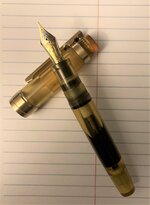
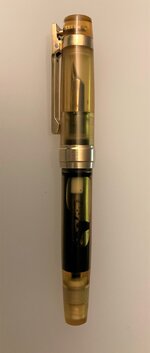
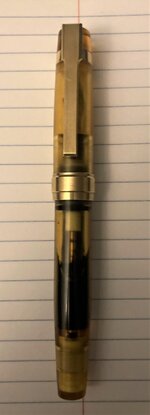
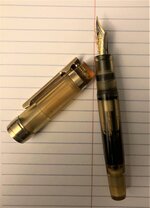
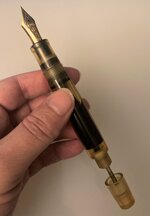
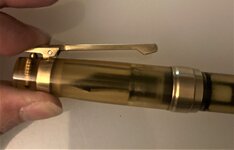
I have for you fine folks today some terrible photos of my latest pen. I'll try to keep the essay short.
The pen is based fairly closely on the Sailor Pro Gear King of Pens which donated the nib unit. I had previously made another pen for this nib, but I didn't much care for the balance. I made it too long and too back heavy. This one is dimensionally very close to the original pen, but about 1/4" longer in the barrel and an 1/8" longer in the cap. Sailor King of Pens are available in all sorts of colors and various materials in prices from around $600 up to around $7,500 depending on material and finish. With the exception of the 600 piston filling pens made for Sailor's 95th anniversary in 2006, all of them are cartridge/converter pens. If you want more ink in the pen you need to either hack together a larger cartridge or get a custom pen made by someone other than Sailor. Also the converter only holds .5ml. This pen holds around 3ml and is configured as a Japanese style eyedropper with a shut off valve.
The pen was made from Ultem plastic and brass, primarily, with a few small pieces of PTFE for the valve plug, o-ring spacers and bearings for the rod inside the blind cap. There are a few other small parts, various o-rings, a spring from an old printer, a stainless pin for the clip, and a 2-56 screw for the valve plug. Everything else was made on my tiny Sherline lathe and mill. All but the 2-56 threads were single pointed.
Overall, I'm happy with how it turned out even though it's still pretty crude in many respects. I'm not sure how I feel about the clip in general and it's not very refined. I don't like how the internal threads show white on the outside of the plastic, but I didn't try to polish them for fear of washing them out. (I made this for myself, so function was far more important than anything cosmetic, but I still wanted it to look nice. I don't like making excuses about my work.) The interface in the section for the housing nipple was bored about a thou larger than I wanted and I knew I'd likely need a gasket to prevent ink from getting around the housing inside the section. I haven't made that gasket yet, so there's ink seeping down the threads. It's unsightly, but it won't leave the interior of the pen, so the fix will wait for now. I'm not wholly sure I can make a section that won't have that problem, so I'm not going to make a new section. ...But I also don't like the few extra turns of threads inside the section that show through, so I might. Same for the internal threads on the cap for the finial. I could have hidden those completely behind the band, but I didn't think that far ahead. I did think about it with the trim and threads at the bottom of the cap, though, and that part came out better than I expected. I also didn't line up the nib with the clip which I meant to do.
Anyhow, not sure I kept that short, but if you read it and have any questions or comments, fire away. In light of recent discussion, I will say I'm completely open to feedback and welcome your opinions. I don't make pens for sale and I'm posting this here to spark discussion as much as anything.





